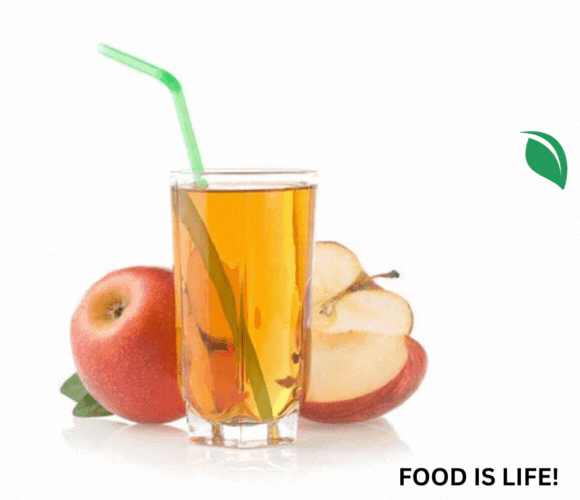·
DIFFERENT JUICES RECIPES | FRESH JUICES RECIPES
(foodeeslife.blogspot.com)
APPLE JUICE
An apple is a type of edible fruit that grows on domestic
apple trees (Malus domestica). The most popular species of apple trees in the
Malus genus are grown all over the world. The tree's wild parent, Malus
sieversii, is still present in Central Asia, the region of origin. Apples have
been cultivated for a very long time in Asia and Europe, and European colonists
brought them to North America. Numerous cultures, including Norse, Greek, and
European Christian tradition, attribute mythological and religious significance
to apples.
Apples raised from seed usually differ significantly from
their parents' varieties, and the offspring frequently lacks desirable traits.
Clonal grafting onto rootstocks is typically used to multiply apple varieties. Without
rootstocks, apple trees have a tendency to grow larger and bear fruit much
later. Rootstocks are used to manage the size and rate of growth of the
eventual tree, making harvesting simpler. There are more than 7,500 different
apple cultivars. Several cultivars are developed for various tastes and applications, including cooking, eating raw, and making cider. Trees and fruit
are susceptible to fungal, bacterial, and insect issues, which can be managed
using a variety of natural and synthetic methods. The genome of the fruit was
sequenced in 2010 as part of studies on disease prevention and selective
breeding for apple production.
In 2021, 93 million tonnes of apples were produced globally,
with China producing the lion's share of that amount.
Physical description of Apple tree:
A particular variety of apple tree can be grafted onto dwarfing or semi-dwarfing rootstocks to produce smaller, less vigorous plants. Apple trees are typically tiny trees. A tree established with standard (seedling) rootstock will frequently grow to a height of 9 metres (30 feet) and have a big crown diameter if left untrimmed. Typically, the bark is dark and scaly. Simple leaves typically have little teeth along their borders and have an oval form. With five white petals that are frequently pink-tinged and many stamens, apple blooms are striking. Bees and other insects pollinate the flowers, and cross-pollination is necessary to fertilise the majority of types. The ripened ovary and surrounding tissue of the apple, which is a pome (fleshy) fruit, both become fleshy and edible. Apples vary in size, shape, and acidity depending on the variety—there are thousands—and are typically roundish in shape, 5–10 cm (2-4 inches) in diameter, and a shade of red, green, or yellow when they are picked. Apple types can be broadly categorised into three groups: (1) cider varieties, (2) cooking variations, and (3) dessert kinds. Although these groups differ greatly, they all tend to emphasise colour, size, aroma, smoothness, and perhaps crispness and tang. Numerous types have low levels of tannin, merely a mild acidity, and a relatively high sugar content.
Apple murabba:
We also use apple in the form of apple murabba. The pulp of apple fruit is used to make apple murabba, also known as "Saib Ka Murabba," which has the amazing power to prevent illness and provide the body with vital nutrients, vitamins, protein, and phytochemicals.
Apples murabba shield the body from a variety of illnesses. It lessens dental decay, increases saliva production, and fortifies teeth. Apple murabba guards against rheumatism, gout, inflammation of the bones, and excruciating arthritis. It is excellent for the brain and aids in the treatment of heart problems and cancer. Apple murabba is incredibly satiating, moist, and healthful.
BENEFITS OF APPLE JUICE FOR HEALTH
1. Apple juice is Nutritious:
Apples are categorised as fruits that are high in nutrients
and offer a lot of nutrients per serving.For a 2,000-calorie diet, the current
Dietary Guidelines for Americans recommend 2 cups of fruit per day, with
an emphasis on whole fruits like apples.
The nutrients in a medium 7-ounce (200-gram) apple are as follows:
· Calories: 104
· 28 grams carbs
· 5 grams of fibre
· 10% of the Daily Value (DV) for vitamin C
· 6% of the DV is copper.
· 5% of the DV for potassium
· 4% of the DV for vitamin K
Vitamins E, B1, and B6 are also present in the same meal at 2-5% of the DV each. Vitamin E functions as a fat-soluble antioxidant, vitamin B1 (thiamine), which is required for growth and development, and vitamin B6 are both crucial for the metabolism of proteins. In addition, polyphenols, a significant class of antioxidants, are abundant in apples. Free radicals are dangerous molecules that destroy your cells and promote the growth of chronic diseases like cancer and heart disease. Antioxidants are substances that shield your cells from these dangerous molecules. These plant chemicals are probably the source of many of the health advantages associated with apples, despite not being listed on nutrition labels. Apples should be eaten with the skin on to obtain the most antioxidants and fibre from them.
2. Linked to a lower risk of diabetes:
Apple consumption is associated with a decreased risk
of type 2 diabetes. Eating apples and pears was linked to an 18% lower
incidence of type 2 diabetes, according to a compilation of studies. In fact, a
weekly serving of only one may lower the risk by 3%. This advantageous impact
may be due to their high quercetin and phloridzin levels, two antioxidant
polyphenols. A significant risk factor for the development of diabetes, insulin
resistance, may be reduced by quercetin's anti-inflammatory properties.
Phloridzin, on the other hand, is thought to lower the absorption of sugar in
the intestines, resulting in lower blood sugar levels and a decreased risk of
diabetes.
3. Apple helps
to prevent cancer:
Apple antioxidants may have protective effects against
specific malignancies, such as tumours of the digestive system, breast, and
lungs.
According to research conducted in test tubes, apple
polyphenols may be responsible for these effects by preventing malignant cells
from proliferating. Additionally, a study conducted on women found that eating
more apples was associated with a lower risk of dying from cancer.
ability to combat cancer may possibly be attributed
to their high fibre content.
For instance, a different test-tube study discovered that
apple pectin fibre may prevent the development of malignant cells and
potentially hasten their demise.
4. Apple Might
encourage weight loss:
Apples are filling due to their high fibre and water
content.
As it helps you control your hunger, a growing sense of
fullness can be used as a weight-loss approach. This could then cause you to
consume less energy.
One study found that eating whole apples prolonged feelings
of satiety for up to 4 hours more than drinking the same volume of apple juice
or purée. This took place because entire apples slow down gastric emptying, or
how quickly your stomach empties its contents.
Additionally, studies indicate that eating apples could
considerably lower Body Mass Index (BMI), a measure of weight-related heart
disease risk.
Interestingly, apple polyphenols might also help prevent
obesity.
5. Apple juice may be able to combat asthma:
Apples high in antioxidants may aid in preventing oxidative
lung damage. Oxidative damage may result from an overabundance of the dangerous
chemicals known as free radicals. Your body may react to this by becoming
inflammatory and allergic.
Apple skin has high levels of quercetin, an antioxidant that
can help control your immune system and lessen inflammation. This might
theoretically make apples useful in preventing late-stage bronchial asthma
reactions.
Animal and test-tube research concur, indicating quercetin
may be an effective remedy for allergic inflammatory conditions like sinusitis
and asthma.
Similar to this, additional elements present in apples, such
as proanthocyanidins, may lessen or stop allergic asthma airway inflammation.
6. potentially protects your brain:
Apples' quercetin may shield your brain from oxidative
stress-related harm.
According to mouse studies, quercetin's antioxidant
properties may guard the brain and nerves against oxidative stress and shield
them from injuries that could lead to degenerative brain conditions like
Alzheimer's disease or dementia.
In addition, quercetin controls oxidative and inflammatory
stress indicators, which may protect against stress-related nerve injury.
7. it
might improve intestinal health:
Pectin, a form of fibre that serves as a prebiotic, can be
found in apples. This indicates that it nourishes the beneficial bacteria in
your stomach, known as the gut microbiota. Your gut microbiota contributes
significantly to your general health by being involved in a wide range of
processes that are related to both health and disease. Better health frequently
depends on a healthy gut. Pectin enters your colon intact because dietary fibre
cannot be digested, which helps the growth of healthy bacteria. The two major bacterial
species in your gut, Bacteriodetes and Firmicutes, are improved in
particular.According to recent research, apples may help prevent chronic
diseases including obesity, type 2 diabetes, heart disease, and cancer by
modifying your gut microbiome in a positive way.
8. Apple consumption is associated with a lower risk of heart disease:
One explanation could
be that soluble fibre, which can help lower blood cholesterol levels, is
present in apples. Additionally, they have polyphenols, which have antioxidant
properties. The peel is where a lot of them are concentrated. The flavonoid
epicatechin, one of these polyphenols, may reduce blood pressure. High intakes
of flavonoids were connected to a 20% decreased risk of stroke, according to a
review of studies. By lowering blood pressure, reducing "bad" LDL
oxidation, and acting as antioxidants, flavonoids can help prevent heart
disease. A different study that compared the effects of eating one apple a day
to the effects of taking statins, a type of medications known to decrease
cholesterol, came to the conclusion that apples would be virtually as
successful at lowering heart disease-related deaths as the medications.
The conclusions should, however, be viewed with caution
because this was not a controlled trial.
Consuming foods with white flesh, such as apples and pears,
has been associated to a lower risk of stroke in another study. There was a 9%
reduction in the risk of stroke for every 25 grammes ingested, or about 1/5 cup
of apple slices.
Apple
juice recipe:
One of the healthiest
and most energizing beverages you can create at home is apple juice. For
creating this juice, you can use apple kinds like Royal Gala, Fuji, or any
local variety you can get in your area because they taste naturally sweet and require
less sugar than other varieties. But be sure to get organic apples that are
wax- and pesticide-free. Do not choose your apples when you are out shopping
based solely on how glossy they appear.
Ingredients:
·
4 apples, medium-sized
·
2 teaspoons optional sugar
·
two cups of cold water
Instructions
·
Four apples should be well rinsed before
peeling.
·
To finish and remove the skin from all of the
apples, repeat.
·
Cut them into rough pieces, and then throw away
the seedy centre.
·
Put them in a basin after giving them a rough
chop.
·
Add apple slices, chopped, to a mixer jar. You
can add 2 teaspoons of lemon juice if you don't want the apples to become
brown.
·
Add 2 cups of ice-cold water.
·
2 teaspoons of sugar should be added. If you
prefer not to have sugar in your juice, you can omit this step entirely.
·
Until smooth, blend.
·
Smooth and well-blended.
·
To a strainer, pour it.
·
Press firmly and fully to obtain juice. Throw
away the remainder.
·
It's time for some freshly brewed apple juice.
Serve right away.
·
Serve after pouring into a serving glass! Serve
with ice cubes if you prefer it cooled.
·
Delicious and reviving apple juice is prepared!



.png)
.gif)




.gif)
.gif)
.gif)
.gif)

0 Comments